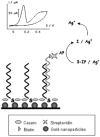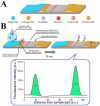An Exploration of Nanoparticle-Based Diagnostic Approaches for Coronaviruses: SARS-CoV-2, SARS-CoV and MERS-CoV
- PMID: 36296739
- PMCID: PMC9608708
- DOI: 10.3390/nano12203550
An Exploration of Nanoparticle-Based Diagnostic Approaches for Coronaviruses: SARS-CoV-2, SARS-CoV and MERS-CoV
Abstract
The wildfire-like spread of COVID-19, caused by severe acute respiratory syndrome-associated coronavirus-2, has resulted in a pandemic that has put unprecedented stress on the world's healthcare systems and caused varying severities of socio-economic damage. As there are no specific treatments to combat the virus, current approaches to overcome the crisis have mainly revolved around vaccination efforts, preventing human-to-human transmission through enforcement of lockdowns and repurposing of drugs. To efficiently facilitate the measures implemented by governments, rapid and accurate diagnosis of the disease is vital. Reverse-transcription polymerase chain reaction and computed tomography have been the standard procedures to diagnose and evaluate COVID-19. However, disadvantages, including the necessity of specialized equipment and trained personnel, the high financial cost of operation and the emergence of false negatives, have hindered their application in high-demand and resource-limited sites. Nanoparticle-based methods of diagnosis have been previously reported to provide precise results within short periods of time. Such methods have been studied in previous outbreaks of coronaviruses, including severe acute respiratory syndrome-associated coronavirus and middle east respiratory syndrome coronavirus. Given the need for rapid diagnostic techniques, this review discusses nanoparticle use in detecting the aforementioned coronaviruses and the recent severe acute respiratory syndrome-associated coronavirus-2 to highlight approaches that could potentially be used during the COVID-19 pandemic.
Keywords: COVID-19; MERS-CoV; SARS-CoV; SARS-CoV-2; coronaviruses; diagnostic techniques; nanoparticles.
Conflict of interest statement
The authors declare no conflict of interest.
Figures







Similar articles
-
Human and novel coronavirus infections in children: a review.Paediatr Int Child Health. 2021 Feb;41(1):36-55. doi: 10.1080/20469047.2020.1781356. Epub 2020 Jun 25. Paediatr Int Child Health. 2021. PMID: 32584199 Review.
-
Current status of antivirals and druggable targets of SARS CoV-2 and other human pathogenic coronaviruses.Drug Resist Updat. 2020 Dec;53:100721. doi: 10.1016/j.drup.2020.100721. Epub 2020 Aug 26. Drug Resist Updat. 2020. PMID: 33132205 Free PMC article. Review.
-
Abelson Kinase Inhibitors Are Potent Inhibitors of Severe Acute Respiratory Syndrome Coronavirus and Middle East Respiratory Syndrome Coronavirus Fusion.J Virol. 2016 Sep 12;90(19):8924-33. doi: 10.1128/JVI.01429-16. Print 2016 Oct 1. J Virol. 2016. PMID: 27466418 Free PMC article.
-
Current diagnostic approaches to detect two important betacoronaviruses: Middle East respiratory syndrome coronavirus (MERS-CoV) and severe acute respiratory syndrome coronavirus 2 (SARS-CoV-2).Pathol Res Pract. 2021 Sep;225:153565. doi: 10.1016/j.prp.2021.153565. Epub 2021 Jul 24. Pathol Res Pract. 2021. PMID: 34333398 Free PMC article. Review.
-
Current Strategies of Antiviral Drug Discovery for COVID-19.Front Mol Biosci. 2021 May 13;8:671263. doi: 10.3389/fmolb.2021.671263. eCollection 2021. Front Mol Biosci. 2021. PMID: 34055887 Free PMC article. Review.
Cited by
-
A Clinical Update on SARS-CoV-2: Pathology and Development of Potential Inhibitors.Curr Issues Mol Biol. 2023 Jan 4;45(1):400-433. doi: 10.3390/cimb45010028. Curr Issues Mol Biol. 2023. PMID: 36661514 Free PMC article. Review.
-
Nanotechnology Applications in Sepsis: Essential Knowledge for Clinicians.Pharmaceutics. 2023 Jun 8;15(6):1682. doi: 10.3390/pharmaceutics15061682. Pharmaceutics. 2023. PMID: 37376129 Free PMC article. Review.
-
Delving Into Nanoparticle Systems for Enhanced Drug Delivery Technologies.AAPS PharmSciTech. 2025 Mar 4;26(3):74. doi: 10.1208/s12249-025-03063-1. AAPS PharmSciTech. 2025. PMID: 40038143 Review.
References
-
- John Hopkins University Coronavirus COVID-19 Global Cases by the Center for Systems Science and Engineering (CSSE) at Johns Hopkins University. [(accessed on 2 August 2022)]. Available online: https://coronavirus.jhu.edu/map.html.
-
- World Health Organization Coronavirus Disease (COVID-19) Pandemic. [(accessed on 28 September 2022)]. Available online: https://www.who.int/europe/emergencies/situations/covid-19.
-
- McKibbin W., Fernando R. The Global Macroeconomic Impacts of COVID-19- Seven Scenarios. SSRN Electron. J. 2020;20:1–30. doi: 10.2139/ssrn.3547729. - DOI
-
- Talic S., Shah S., Wild H., Gasevic D., Maharaj A., Ademi Z., Li X., Xu W., Mesa-Eguiagaray I., Rostron J., et al. Effectiveness of public health measures in reducing the incidence of COVID-19, SARS-CoV-2 transmission, and covid-19 mortality: Systematic review and meta-analysis. BMJ. 2021;375:e068302. doi: 10.1136/bmj-2021-068302. - DOI - PMC - PubMed
Publication types
LinkOut - more resources
Full Text Sources
Research Materials
Miscellaneous

